It was a nice day in May of 2016 when I received a message from a small, local rescue about a new dog, which they really didn’t know what to do with. A year-old Red Heeler from the Valencia County Shelter had previously been adopted, until the people returned him. They said that Zack was absolutely vicious upon even seeing any other dog, and impossible to control.

As that is a very small municipal shelter, Zack likely wouldn’t have made it out again. But, fortunately Nancy at the Southwest Animal Rescue Fund (SWARF) decided to give the young guy a try. Soon after she saw Zack’s behavior, I got a message from her. Stopping over there with one of my training dogs, Zack immediately had a screaming and jumping fit, seemed all ready to launch into a headfirst zombie attack and she could barely hold him back. As he’s a young and smaller dog it was rather high-pitched, but loud enough to alarm everybody around (including passing traffic).
But, the Training Dog Remained Calm
However, my training dog Sonny said there was no aggression, but just excitement and being very nervous at meeting new dogs. Zack already loved people and was very responsive, so what he really needed was dog-dog trainers, and I happened to have three of them.
The Team Takes Over
I rarely get pictures of the early stages, as I’m one person and we’re all too busy then. But Nancy from SWARF knows what the start would have sounded like. In about two hours my little Cher and I had Zack calmed down enough to run loose, with just a dragging leash. I was then off for a large cup of coffee, and Cher now took over. As Zack was now deferring to her, she would prompt activity then stop him when he did something wrong, or walk away when he was too excited, not returning until Zack calmed down. The other two dogs just stayed away, with Sonny correcting Zack for any approach. Bandi just sat and watched, the master of the hard stare which could stop Zack in his tracks, and as the Senior he now gets to supervise.
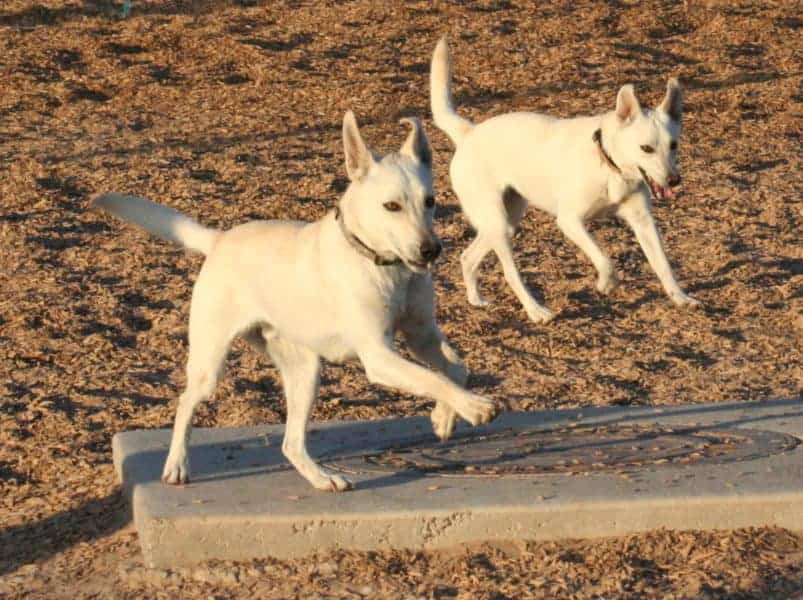
Over all the years and all the dogs, my three had each chosen and practiced their particular roles, and they worked as a team. With the young and wild ones, it was always Cher. For the rambunctious teens, it was Sonny. With the very scared or aggressive dogs, that would always be Bandi.
As Cher had extensively studied Desensitization and Counter-Conditioning, she knew just what to do with Zack. And, when at one point Zack started muzzle-punching her, Cher clearly demonstrated that she is not some silly Force-Free-Positive-Only trainer. About 4 hours later, I saw the first signs of play that Cher permitted, then she called a halt and sent the tired Zack off for a nap. But, from that point on, Zack was safe to be free in the house with the three other dogs, as he would defer to each of them.
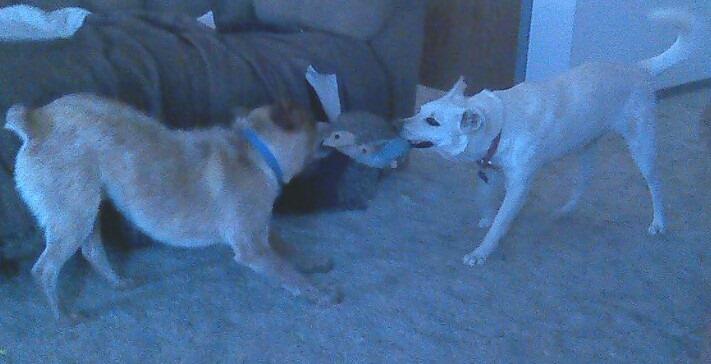
Initial Assessment
A trip to Lowe’s and Zack did fine with the people and the store, but caught sight of two dogs, including a little white one. As was expected to happen this soon, all the noise and jumping started. We stopped by the SWARF rescue to say hello, then home for rest and evening training with Cher. This trip was managed and supervised by the Senior Trainer, Bandi. I was mostly along to drive the car.
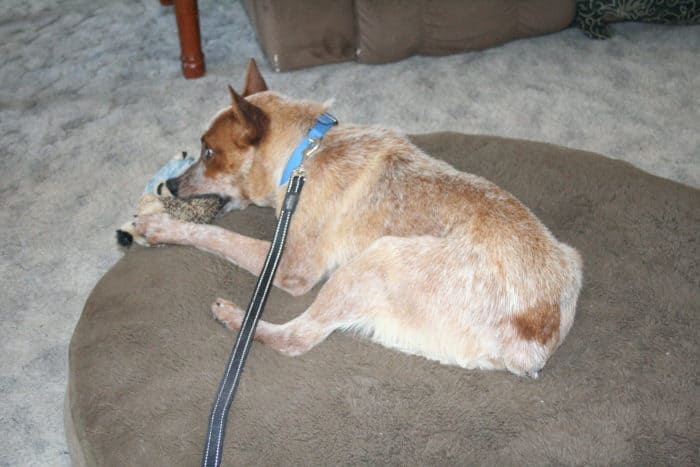
And the purpose of that trip this early was to get an accurate assessment of just how Zack was currently acting in those situations, so that we have a known starting point.
A Former Student Returns to Teach
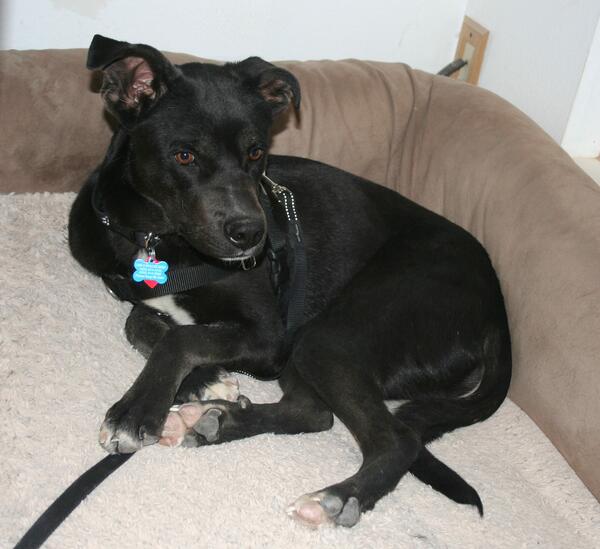
On the second day a former foster, Steel, came back for a bit. Now, Steel’s one exceptional dog, with great social skills. It took me about 10 minutes to calm down Zack’s screaming and lunging, then I left him behind a fence and waited. Steel would start from about 20 feet away, relaxing, leaving, and coming back repeatedly until Zack calmed down. All while I had another coffee.
After less than an hour, Steel was now against the fence, having Zack copy his play bows, then lay down calmly. At that point I allowed direct contact, with Zack still on leash. While he’s very good, young Steel does not yet have Cher’s experience, so I had to briefly correct Zack for muzzle-punching. When Steel felt it was enough, he’d just turn his head up and away, and start to walk, so I’d have to stop Zack from following him. When Cher had done that, she’d first tell Zack to back away, and he would, but Steel didn’t realize it needed more emphasis.
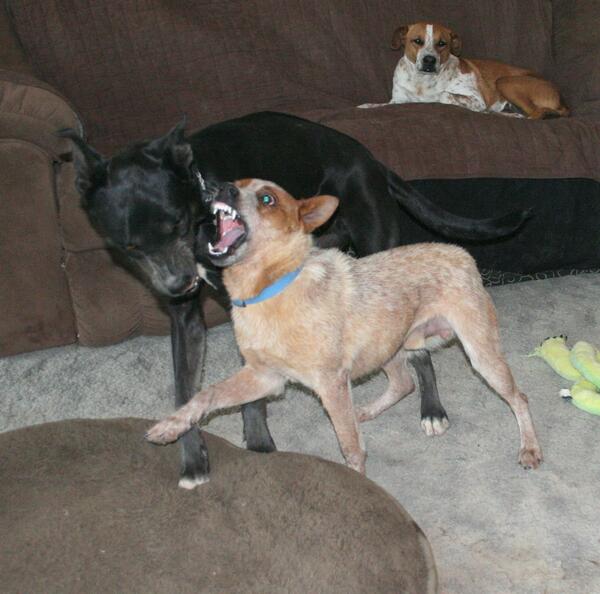
Normally, I would not have introduced Steel as yet, but another rescue was having trouble with him and they needed a place to park him for a few days. A whole other story as young Steel had been very bored there, and the rescue never understood what he needed. When I went to pick up Steel, he literally jumped into my car.
Zack playing with Steel, and Bandi supervising the kids.
Starting the Dog Park
By the morning of the 3rd day, Steel and Zack were playing just fine, rolling in the dirt together. Heading out to the field near the dog park with Zack and Bandi, we walked at a controlled distance from other dogs, letting Zack get used to calming down with other dogs close by. Then, into the empty side of the dog park, to let him sniff and get familiar. We were about to leave when a single dog came in, a playful and well known lady named Luna with good social skills, so why not give it a try? Again starting from outside the fence, but this time only 10 minutes until we entered, and another ten before Zack and Luna were running and playing.
At this point we had great progress, but still a lot of work to come. Zack’s social skills were midway between puppy and teenager, and Cher and the others needed to help him work on that. Zack now knows how to meet dogs, but will need practice in meeting new dogs, and each one he meets is then no longer a new one, so we’ll need a plentiful supply. While Zack accepts corrections from other dogs, he likely would not know proper behavior with a scared dog or a dog with poor social skills, so we need to pick his playmates for a while. Once Zack’s comfortable with a group, we’ll meet the scared ones inside of a group of social dogs, which will prevent him from fixating on them as the other dogs will have most of his attention, and he’ll also see how they treat the shy ones.
Teaching, not Restraining
And, while Steel knows how to share toys, Steel doesn’t understand that Zack does not know, or how to deal with that. My three training dogs, however, have worked with many resource guarders, and know that’s a natural behavior for those dogs who haven’t learned to share. Beyond what was mentioned here, Zack was also being trained in relaxation and simple obedience commands, with a focus on those needed to guide and control a dog, so that you can verbally influence his behavior when meeting other dogs.
Whenever possible here, you want to avoid physical restraint or coercion, so that the dog learns new behaviors which prevent the issue. If you were to only pull him away and yell at him, the dog would only learn you didn’t like what he did, but he’d still have no clue on how to prevent that the next time.
Completing the Dog Park
On the 4th day we went back to the dog park, with a dozen dogs inside today. Starting at a distance, alternating with stopping to watch, then walking on as he became too excited, and controlling the distance and moving out of sight of others at times. After 1/2 hour, we were inside the small-dog area, and periodically getting closer to the fence.
Here you judge the excitement by both the intensity and the time it takes him to recover. On intensity the dog (and you) must still be able to somewhat control him, and recovery (when brought away from the stimulus) should be no more than 20 seconds. If recovery times start increasing, reduce the intensity and duration, with longer rest times between passes. For the wildest of dogs, the first few passes may be for only 10 seconds or so. At some point the dog will become too tired, and none of that will improve the recovery time, as a sign to quit for that session.
By the end of an hour, the two wildest dogs inside could come over for a brief fence run. Zack would loudly reply and run, but stay in control, and he could be verbally called back from the fence and would quickly sit and relax just a few feet away. This is both a test of the control commands he had been taught, and an exercise to measure and improve his impulse control. After a little practice, I could recognize when Zack was just starting to get too excited, and verbally calm things down. Using physical restraints not only takes much longer in any incident, but really teaches very little. With the verbal commands Zack would quickly back away, which allowed him to rapidly calm down.
One Size Never Fits All
Overall, the exposure/withdraw/relaxation with other dogs happened over 50 times, often very briefly. Of special note here, no food treats were used at any time. None were needed, and experience (and even that Science thing) has shown that food would be a distraction that could greatly slow down the process with this issue. A truly fear-reactive dog would be a different story and would have been handled quite differently, but that’s not Zack. Similarly for a dog severely lacking in all social skills with dogs, or several other issues. Other approaches such as clicker training with food rewards might have (eventually) worked here, but this approach for this type of case took weeks of potential effort down to only hours.
The Science That Worked
For the technical side, we started with Classical Reward training, then moved to something often called Positive Reinforcement. Cher applied Interruption and Punishment for the muzzle punching and a few other times, but they were followed by Reinforcement and Autoshaping. For most of that effort, I was just sipping coffee and reading the news. The only use of food was in learning to eat meals and treats next to other dogs and not jumping on people having treats. Areas which are ongoing and will need about a week more to complete.
In less than two weeks here, Zack was just fine eating meals next to three other dogs, taking treats by name, and allowing another dog to take a treat right in front of him. With all the toys now out, there remained a slight bit of guarding, but Zack then submits with no escalation, so this will fade by itself over time.

At that point Zack had over a half-dozen trips to the dog park, and met over 30 new dogs without issue. The very scared or high-energy dogs who do not correct remain beyond Zack, but that would be expected given his age and limited socialization. Similarly, his old habits of muzzle punching and fur snapping occasionally show up, but he is responsive to either a mild verbal reprimand or the other dog correcting the behavior.
With a good daily dose of activity and social contact with other dogs, Zack is very much ready for conventional obedience training and soon for adoption.
After thirteen days here, Zack left for a Cattle Dog rescue in Arizona.
How Typical Was This?
Most problem dogs come in being scared of some combination of people, other dogs, or the world. In that situation the dog can flee, freeze, or advance. Most do the first, but Zack and a few others just advance. As that makes them more scared, they rapidly become reactive and often aggressive. And, in Zack’s case, quite loud.

The majority of those dogs are fine and adoptable in 4-6 weeks. Due to scheduling constraints Zack had a shorter stay, preparing him for a rescue to complete the work.
The times I’ve given here relate to multiple daily sessions with both a person and training dogs who have done this hundreds of times before. For a typical dog trainer with a board-and-train it would take perhaps 3+ times as long. And longer yet in a foster home, or especially with new adopters as their first dog.
And all that is if it’s even possible for them at all. I’ve had many failures or referrals from dog trainers where the dog’s obedience seems fine, but they have no idea how to teach and change social behaviors.
